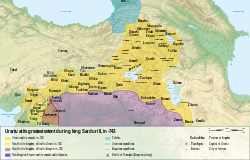 Global Information
Global InformationUrartu information
Urartu (exonym)[a] | |||||||||||||
|---|---|---|---|---|---|---|---|---|---|---|---|---|---|
| 860 BC – 590 BC | |||||||||||||
 Urartu under Sarduri II, 743 BC | |||||||||||||
| Capital |
| ||||||||||||
| Common languages |
| ||||||||||||
| Religion | Urartian polytheism[3] | ||||||||||||
| Government | Monarchy | ||||||||||||
• 858–844 | Aramu | ||||||||||||
• 844–834(?) | Lutipri(?) | ||||||||||||
• 834–828 | Sarduri I | ||||||||||||
• 828–810 | Ishpuini | ||||||||||||
• 810–785 | Menua | ||||||||||||
• 785–753 | Argishti I | ||||||||||||
• 753–735 | Sarduri II | ||||||||||||
• 735–714 | Rusa I | ||||||||||||
• 714–680 | Argishti II | ||||||||||||
• 680–639 | Rusa II | ||||||||||||
• 639–635 | Sarduri III | ||||||||||||
• 629–590 or 629–615 | Rusa III | ||||||||||||
• 615–595 | Sarduri IV | ||||||||||||
• 590–585 | Rusa IV | ||||||||||||
| Historical era | Iron Age | ||||||||||||
• Established | 860 BC | ||||||||||||
• Median conquest (or Achaemenid conquest in 547[4]) | 590 BC | ||||||||||||
| |||||||||||||
| History of Armenia |
|---|
 |
| Timeline • Origins • Etymology |
Urartu (/ʊˈrɑːrtuː/; Assyrian: māt Urarṭu,[5] Babylonian: Urashtu, Hebrew: אֲרָרָט Ararat) was an Iron Age kingdom centered around Lake Van in the Armenian Highlands. It extended from the eastern bank of the upper Euphrates River to the western shores of Lake Urmia and from the mountains of northern Iraq to the Lesser Caucasus Mountains.[6] Its kings left behind cuneiform inscriptions in the Urartian language, a member of the Hurro-Urartian language family.[6] Since its re-discovery in the 19th century, Urartu, which is commonly believed to have been at least partially Armenian-speaking,[2][7][8][9][10] has played a significant role in Armenian nationalism.[11]
The kingdom emerged in the mid-9th century BC and dominated the Armenian Highlands in the 8th and 7th centuries BC.[12] Urartu frequently warred with Assyria and became, for a time, the most powerful state in the Near East.[12] Weakened by constant conflict, it was eventually conquered by the Iranian Medes in the early 6th century BC.[13] Archaeologically, it is noted for its large fortresses and sophisticated metalwork.[14]
Cite error: There are <ref group=lower-alpha> tags or {{efn}} templates on this page, but the references will not show without a {{reflist|group=lower-alpha}} template or {{notelist}} template (see the help page).
- ^ Van de Mieroop, Marc (2007). A History of the Ancient Near East, ca. 3000-323 BC. Blackwell Publishing. p. 215.
- ^ a b Diakonoff, Igor M (1992). "First Evidence of the Proto-Armenian Language in Eastern Anatolia". Annual of Armenian Linguistics. 13: 51–54. ISSN 0271-9800.
- ^ Takahito, Prince Mikasa; Avia Taffet; Jak Yakar (1998). "Politics and religion in Urartu". Essays on Ancient Anatolia in the Second Millennium B.C. Vol. 10. Chūkintō-Bunka-Sentā Tōkyō: Harrassowitz Verlag. pp. 133–140. ISBN 9783447039673. ISSN 0177-1647.
{{cite book}}:|journal=ignored (help)CS1 maint: multiple names: authors list (link) - ^ Nunn, Astrid (2011-05-15). "« The Median 'Empire', the End of Urartu and Cyrus the Great's Campaign in 547 BC (Nabonidus Chronicle II 16) ». Ancient West & East 7, 2008, p. 51-66". Abstracta Iranica. Revue bibliographique pour le domaine irano-aryen (in French). 31. doi:10.4000/abstractairanica.39422. ISSN 0240-8910.
Après citation des passages pertinents, analyse des toponymes et une nouvelle lecture de la Chronique de Nabonide II 16, dont le nom géographique clef doit être lu « Urartu », il reste : Cyrus le Grand a « marché vers Urartu et vaincu son roi ». Urartu n'a donc pas été détruit par les Mèdes à la fin du VIIe s. mais a continué à exister comme entité politique jusqu'au milieu du VIe s. La Chronique de Nabonide (II 16) montre bien que la conquête de Cyrus le Grand mit fin à ce royaume.
- ^ Eberhard Schrader, The Cuneiform inscriptions and the Old Testament (1885), p. 65.
- ^ a b Cite error: The named reference
:1was invoked but never defined (see the help page). - ^ Encyclopedia of Indo-European culture. Mallory, J. P., Adams, Douglas Q. London: Fitzroy Dearborn. 1997. pp. 30. ISBN 978-1884964985. OCLC 37931209.
Armenian presence in their historical seats should then be sought at some time before c 600 BC; ... Armenian phonology, for instance, appears to have been greatly affected by Urartian, which may suggest a long period of bilingualism.
{{cite book}}: CS1 maint: others (link) - ^ Robert Drews. Militarism and the Indo-Europeanizing of Europe. Routledge. 2017. p. 228. "The vernacular of the Great Kingdom of Biainili was quite certainly Armenian. The Armenian language was obviously the region's vernacular in the fifth century BC, when Persian commanders and Greek writers paired it with Phrygian. That it was brought into the region between the early sixth and the early fifth century BC, and that it immediately obliterated whatever else had been spoken there, can hardly be supposed; ... Because Proto-Armenian speakers seem to have lived not far from Hurrian speakers our conclusion must be that the Armenian language of Mesrop Mashtots was descended from an Indo--European language that had been spoken in southern Caucasia in the Bronze Age."
- ^ Hrach Martirosyan (2013). "The place of Armenian in the Indo-European language family: the relationship with Greek and Indo-Iranian*" Leiden University. p. 85-86.
- ^ Petrosyan, Armen. "The Armenian Elements in the Language and Onomastics of Urartu." Aramazd: Armenian Journal of Near Eastern Studies. 2010. [1]
- ^ Redgate, Anne Elizabeth (2000). The Armenians. Wiley. ISBN 978-0-631-22037-4., p. 276.
- ^ a b Zimansky, Paul E. (2011-01-01). "Urartu". The Oxford Encyclopedia of Archaeology in the Near East. Oxford University Press. doi:10.1093/acref/9780195065121.001.0001. ISBN 978-0-19-506512-1. Retrieved 2018-11-22.
- ^ Jacobson, Esther (1995). The Art of the Scythians: The Interpenetration of Cultures at the Edge of the Hellenic World. BRILL. p. 33. ISBN 9789004098565.
- ^ Zimansky, Paul E. (2011-01-01). "Urartu". The Oxford Encyclopedia of Archaeology in the Near East. Oxford University Press. doi:10.1093/acref/9780195065121.001.0001. ISBN 978-0-19-506512-1. Retrieved 2018-11-22.